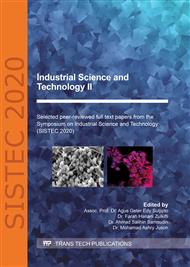[1]
Akter, S., Islam, M. T., Zulkefeli, M., Khan, S., Agarwood Production - A Multidisciplinary Field to be Explored in Bangladesh, International Journal of Pharmaceutical and Life Sciences. 2(1) (2013) 22-32.
DOI: 10.3329/ijpls.v2i1.15132
Google Scholar
[2]
Mohamed, Rozi., Jong, Phai., Abd Kudus, Kamziah., Fungal inoculation induces agarwood in young Aquilaria malaccensis trees in the nursery, Journal of Forestry Research. 25 (2014) 201-204.
DOI: 10.1007/s11676-013-0395-0
Google Scholar
[3]
Mohamed R., Jong PL., Nurul Irdayu I., Succession patterns of fungi associated to wound-induced agarwood in wild Aquilaria malaccensis revealed from quantitative PCR assay, World J Microbiol Biotechnol. 30 (2014) 2427-2436.
DOI: 10.1007/s11274-014-1668-2
Google Scholar
[4]
Tan, J.-J., X.-X. Gao, W.-M. Zhang, W. Lei, and L.-H., Molecular identification of endophytic fungi from Aquilaria sinensis and artificial agarwood induced by pinholes-infusion technique, African J. Biotechnol. 12 (2013) 3115–3131.
Google Scholar
[5]
Sen, S., Dehingia, M., Talukdar, N. et al., Chemometric analysis reveals links in the formation of fragrant bio-molecules during agarwood (Aquilaria malaccensis) and fungal interactions, Sci Rep. 7 (2017) 44406.
DOI: 10.1038/srep44406
Google Scholar
[6]
Lim, T. and A. Noorainie, Wood for the Trees: a review of the agarwood (gaharu) trade in Malaysia, TRAFFIC Southeast Asia. (2010).
Google Scholar
[7]
Naef, R., The volatile and semi-volatile constituents of agarwood, the infected heartwood of Aquilaria species: A review, Flavour and Fragrance Journal. 26 (2011) 73–87.
DOI: 10.1002/ffj.2034
Google Scholar
[8]
Mehta, R., P. Kumar, S. Goyal., Chemo Toxicity Investigation and Physio Chemical Analysis of Composite Samples of Chemical Waste Effluent with Soil, International Journal of Information Research and Review, 3 (2016) 2115–2117.
Google Scholar
[9]
Radojevic, M., V. N. Bashkin, Practical Environmental - Analysis, 2nd ed. Cambridge, UK: The Royal Socety of Chemistry. (2006).
Google Scholar
[10]
Forestry Department Peninsular Malaysia, Manual in Grading of Agarwood, Alamedia Sdn. Bhd., Selangor, Malaysia. (2015).
Google Scholar
[11]
Tajuddin, S. N., M. M. Yusoff, Chemical composition of volatile oils of Aquilaria malaccensis (Thymelaeaceae) from Malaysia, Natural Product Communications. 5 (2010) 1965–(1968).
DOI: 10.1177/1934578x1000501229
Google Scholar
[12]
Liu, Y., J. Wei, Z. Gao, Z. Zhang, J. Lyu., A Review of Quality Assessment and Grading for Agarwood. Chinese Herb. Med. 9 (2017) 22–30.
Google Scholar
[13]
Burke, I. C., C. M. Yonker, W. J. Parton, C. V. Cole, K. Flach, D. S. Schimel., Texture, Climate, and Cultivation Effects on Soil Organic Matter Content in U. S. Grassland Soil, Soil Science Society of America Journal. 53 (1989) 800–805.
DOI: 10.2136/sssaj1989.03615995005300030029x
Google Scholar
[14]
Folland, C. J., M. S. K. Acres, B.D., R.P. Bower, P.A. Borrough, The soils of Sabah. Classification and Description, Land Resource Study No. 20, Land Resource Division, Volume 1. Ministry of Overseas Development, England. (1975).
Google Scholar
[15]
Burt, R., Kellogg Soil Survey Laboratory Methods Manual. Soil Survey Investigations Report No. 42, Version 5.0. U.S. Department of Agriculture, Natural Resources Conservation Service, Lincoln, Nebraska. (2014).
Google Scholar
[16]
Gasim, M. B., B. S. Ismail, S.-I. Mir, S. Abd. Rahim, M. E. Toriman, The Physico-chemical Properties of Four Soil Series in Tasik Chini, Pahang, Malaysia, Asian J. Earth Sci. 4 (2011) 75-84.
DOI: 10.3923/ajes.2011.75.84
Google Scholar
[17]
The Potash Development Association, Soil analysis: Key to Nutrient Management Planning, Potash Development Association, United Kingdom. (2011).
Google Scholar
[18]
Jones, J. B., Laboratory Guide for Conducting Soil Tests and Plant Analysis. CRC Press LLC, New York, US. (2001).
Google Scholar


